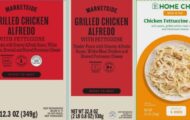When thinking about food safety, most people don’t think about pet food as a health risk. But there have been outbreaks linked to contaminated pet food in the past few years. Earlier this year, Salmonella Reading bacteria sickened two Minnesota children when raw pet food was brought into their home. The CDC has tips for pet owners to protect their health and the health of their pets.

First, the CDC does not recommend feeding raw diets to pets. Those foods can be contaminated with E. coli, Salmonella, and Listeria monocytogenes bacteria. You can get sick from handling the food, and your pet can also contract an infection and pass it on to you.
In fact, some animals can carry these pathogenic bacteria without showing any signs of illness. The bacteria are shed in the animal’s feces, and can get onto their coat and feet. When you pet them, or when they come into your house, the bacteria can be transferred to you.
Dry and canned food can also be contaminated. Stay aware about recalls for food products for your pets.
Make sure that you always wash your hands well with soap and water after handling any pet food. Keep kids away from dog and cat food dishes. If you feed a raw diet, make sure you clean and disinfect all surfaces that the raw food has touched, including countertops, refrigerators, bowls, knives, and forks.
Safety store pet food. Freeze raw pet food until you are ready to serve it. Keep raw pet food away from other foods in your fridge and freezer. Do not thaw frozen raw pet foods on the counter or in the sink; they should be thawed in the fridge overnight. And throw away any food your pet doesn’t eat.
Young children are most at risk for food poisoning because their immune systems are still developing and they are more likely to put their fingers into their mouths. Children under the age of 5 sold not touch pet foods, treats, or supplements. And supervise young children when washing their hands or playing with pets.




